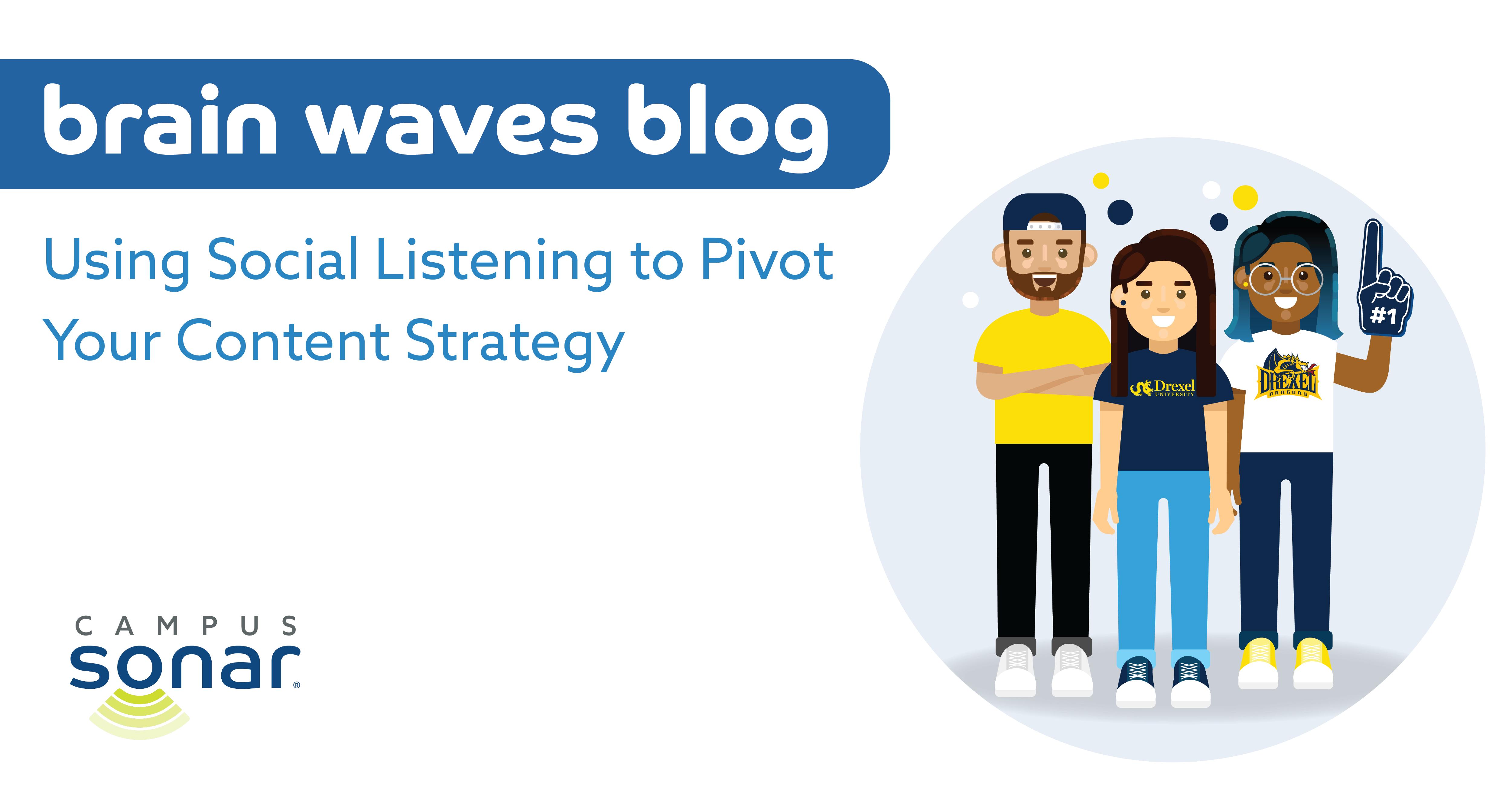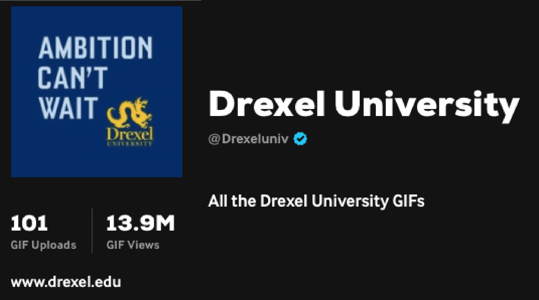Using Social Listening to Pivot Your Content Strategy

A few short months after beginning my MBA at Drexel University, I landed the role of social media strategist in Drexel’s Office of University Communications. With no professional marketing experience under my belt, I was suddenly responsible for being the digital voice of a prestigious institution with a combined social media audience of over 260,000 followers.
However, as a Drexel student and employee—both the marketer, and the target audience—I was in a unique position to bring a fresh, student-focused perspective to Drexel’s digital student engagement strategy.
Here’s how in a matter of one year, in collaboration with my supervisors and mentors, Carrie Roye and Joseph Master, we managed to double Drexel’s monthly social reach, increase engagement by upwards of 90 percent, and gain over 20,000 new followers across our social media channels.
The Giphy Project
About a month into my new role, I broke the rules.
Like most major universities, Drexel has its own brand style guide—a comprehensive reference tool used by the university to maintain brand consistency across all communications channels. It provides detailed guidelines on everything from fonts and colors to usage of the university logo to editorial style and grammar (which, to my dismay, forbids the use of the Oxford comma).
I spent my first few weeks on the job carefully scouring the guidelines and triple-checking my work before pushing “send” on any post. After a few weeks, what seemed at first to be a tedious feat quickly became second nature. I memorized the hex codes for blue and gold, learned to always include the punctuation in a.m./p.m. and, hardest of all, eradicated the Oxford comma from my memory. I learned to be the voice of Drexel University.
With the 2019 graduation season fast approaching, Drexel’s university-wide commencement was my first major undertaking in the role of social media strategist. As part of our marketing efforts (and my first major solo project), I created a Giphy account for Drexel. If you’re not familiar, Giphy is an online database for creating and sharing animated looping images, which can be searched and used freely by users on nearly all major social media platforms. With commencement right around the corner, I wanted to provide a fun way for students to share their school pride and excitement—so I got to work creating a variety of Drexel-themed GIFs (commonly called “stickers” on Instagram) for our audience to use on social media. Our new Giphy account was quickly verified and then it was off to the races with content creation.
Being new to my role, new to higher ed marketing, and new to the field of marketing in general, I was thrilled when my first major solo project was met with overwhelming positivity from our audience. We received hundreds of comments and messages applauding our new Drexel stickers, and in the midst of all the praise, something interesting happened: we began receiving requests. Our Instagram inbox became flooded with messages from students asking us to create stickers representing their majors, sports teams,clubs, individual colleges—you name it. I quickly streamlined the request process by running a Q&A-style series of Instagram stories to simply ask, “What Drexel stickers would you like to see?” As you can imagine, the requests skyrocketed. This was an important moment in developing our future strategy, as it showed us the power of direct communication with our audience and opened our eyes to a new aspect of social listening.
I began eagerly fulfilling as many sticker requests as time allowed, and we began amassing hundreds of thousands of views on our Giphy channel. This is great, right? Social listening has spoken, the people love it! What could go wrong?
Breaking the Rules
Unfortunately, we hit a roadblock when the project was met with pushback from several department heads and communications leaders. Some of our new stickers strayed from Drexel’s style guidelines—whoops.
The pushback led to a pivotal discussion about where we would take Drexel’s social media strategy moving forward. We were faced with an interesting predicament; on one hand, it’s extremely important for a brand to maintain a consistent voice and image, especially when that brand is a large and well-known university. On the other hand, our audience absolutely loved this project. We were gaining massive amounts of organic engagement and free brand exposure from our stickers, while simultaneously appeasing our target audience. So at what cost should we have sacrificed all the positive outcomes, simply in the name of following the rules?
With the support of my supervisors, and approval (excitement, even!) from the head of University Communications, we used the Giphy project to redefine what it means to “follow the rules” when it comes to social media and higher ed marketing.
I’m proud to say that as we approach the one-year anniversary of the Drexel Giphy account, we've designed and uploaded over 50 unique Drexel stickers, surpassing 12.8 million total views across social media. The overwhelmingly positive response to the Giphy project gave us momentum to continue down this new experimental path and focus on social listening as the driving force behind our new social media strategy.

A New Approach
The success of our Drexel-themed stickers opened our team’s eyes even further to the power of social listening and, most importantly, emphasized the power of open communication with our audience. After the Giphy project, we knew students had strong opinions on what they wanted to see from us. So how do we capitalize on this opportunity? Fortunately, I happened to be a member of the target audience. I asked myself: what would I like to see from my university’s social media accounts?
My friends. My classmates. I wanted to see, well, me. I wanted to see life as a student at Drexel University. And not a scripted, professionally shot and strategically edited version of life on campus. I wanted to hear from actual students like me and what their experiences were like as Drexel students. But of course, I’m just one student—I needed to find out if my peers felt the same way.
I ran a Q&A-style series on the Drexel Instagram account via the Questions, Poll, and Quiz features. I asked simple questions, like “What do you want to see more of on the Drexel accounts?” with options such as A) campus photos, B) student stories, C) Co-op features, or D) Philly photos. Similar to our strategy with the Giphy project, I also asked open-ended questions so students could provide unique suggestions. We received an influx of student responses, providing us with a brand new arsenal of ideas directly from our target audience. I found that, like me, students wanted to see themselves. Their friends. Their classmates. The real, raw, unscripted Drexel student experience. From countless suggestions for day-in-the-life stories to student takeovers, the common thread was clear—students want to see Drexel from the eyes of, well, students.
Now that we knew what our target audience wanted to see, we had to leverage this information into a sustainable strategy across our accounts.
Drexel Co-op Series
Synergy was on our side, as the 2019–2020 academic year marked the hundredth anniversary of Drexel’s Cooperative Education Program. Naturally, a milestone of this caliber was a goldmine for social media content. It also provided the perfect opportunity to showcase the Drexel Co-op experience through the eyes of Drexel students. What better way to put our new content strategy into action?
Drexel is best known for its Cooperative Education Program. Students come to Drexel from across the country and all over the world for the Drexel Co-op experience. The goal of this project was to highlight the experience from an entirely student-focused perspective. Learning from our success with the Giphy project, we took a similar approach by directly communicating with our audience. We rolled out a series of Instagram stories and tweets, asking students interested in sharing their Co-op experience to reach out to us. What we received in return were excited students, eager to share their stories on our large platform. Our student volunteers provided us with takeover-style content in the form of both videos and photos, which we used to design dynamic, engaging Instagram stories with an overarching Drexel look and feel.
The final result was a collection of user-generated Instagram stories, housed permanently on our Instagram profile in a “Co-op” highlight, where both current and prospective students could see the possibilities and unique opportunities a Drexel education offers. We’ve received incredibly positive feedback on our student Co-op features, as they emphasize what it truly means to be a Drexel student.
Our Steps to Social Success
- Identify our differentiator. Drexel is best known for its renowned cooperative education program—when you hear Drexel, you think of Co-op. Knowing Drexel’s differentiator, along with the anniversary celebration of the Co-op, we were in the sweet spot for a new social media undertaking.
- Conduct social listening. Before rolling out any new series on our social accounts, we researched what our audience was already saying about the topic. In this case, we monitored Drexel Co-op hashtags, but more notably, we directly asked questions of our audience. We asked students what they wanted to see, and in return we received eager responses and fresh new student-focused ideas.
- Gather user-generated content. In our case, we communicated with our students through both email and Instagram direct messages. We provided them with minimal direction, allowing them to be creative and tell their story in their own way. We collected a combination of video and photo content, allowing for a more dynamic and engaging final product.
- Use the content effectively. Once we received the content from our student volunteers, we used our own expertise to design engaging, on-brand stories and graphics to share on Instagram, but also across all our social platforms. We always tagged students, organizations, and other parties mentioned to allow for shareability, and included relevant hashtags to increase searchability.
- Monitor the response. An important part of implementing any new marketing strategy is, of course, seeing how the audience responds. With both the Giphy project and the Co-op series, we observed a huge positive shift in reach, engagement, and overall audience sentiment—especially from Drexel students.
Moral of the story—don’t be afraid to communicate with your audience! Sometimes the key to a successful strategy is as simple as asking your audience what they want to see. And, sometimes, breaking the rules pays off in the end.

